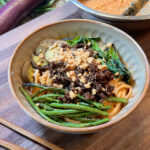Kimchi fried rice is a classic Korean dish that’s both incredibly flavorful and so simple to prepare. It’s versatile enough to add in any protein or vegetable you prefer: making it perfectly filling for any meal!
I used to be roommates with one of my Korean classmates who always shared his kimchi fresh from his parents’ home. Instead of paying everyday for our meals in the university cafeteria, we’d always just buy a rotisserie chicken from the nearby supermarket and eat it with the homemade kimchi which helped us budget tremendously.
This was one of those memorable dishes that he taught me how to make: kimchi fried rice. A Korean staple, it’s a humble fried rice dish made up of kimchi, with sometimes even pork and egg mixed in to make it even more filling. Feel free to substitute the meat with mushrooms or omit it entirely for a vegetarian option!

Kimchi is essentially a Korean fermented side dish. It’s mainly composed of napa cabbage mixed with Korean radishes and green onions, which is all seasoned with a robust mixture of garlic, ginger, chili flakes, and fish sauce (to name a few).
You can use store-bought Kimchi, or make your own. The importance here is we want a well-fermented (aged) kimchi, which tends to be more on the sour side. It’s flavor becomes rich and tangy, which is perfect for this fried rice recipe!

Ingredients for kimchi fried rice
- Kimchi: the star ingredient. You can buy buckets of kimchi in almost any Korean or Asian supermarket. Different brands do have different tastes/consistencies, so you might have to go through a couple to see which one you like the best (if you haven’t already!). Otherwise, if you’re really keen on the particular taste of your kimchi, then homemade kimchi is an option I’d 100% recommend.
- Gochujang: aka. Korean fermented chili paste. It’s spicy, savory, and slightly sweet. This will help add that extra depth of flavor to our kimchi fried rice!
- Day-old rice (preferably short grain): I always emphasize using day-old rice to make any fried rice recipe because they tend to be less moist, and therefore become less mushy/soggy in the final fried rice. But have no fear! If fresh rice is all you have, then simply spread it out on a plate and leave it in the fridge, uncovered, for around 15-30 minutes to let it dry up slightly before cooking.
- Pork belly: the protein component to the fried rice. Because pork belly already has so much fat, we don’t need to use any oil for this recipe! You can substitute the pork belly with bacon, or even mushrooms for a vegetarian option.
- Onion, scallions, sugar, sesame oil: these are some of the extra seasonings we’ll be adding to the rice to boost its flavor profile. The onion and scallions add a slight freshness and aromatic taste, the sugar counter-balances the tanginess of the kimchi, while the sesame oil gives it a nice, toasty finish.
Instructions
Fry the pork belly over medium heat until browned and cooked all the way through (no oil is needed for this step!). Remove the pork and set aside, leaving the remaining rendered fat in the pan.

Add in the onions, saute for 2-3 minutes until tender and translucent.

Add in the kimchi, and continue to stir fry for an additional 2-3 minutes.

Stir in the gochujang and sugar until smooth. Add in the rice, scallions, sesame oil, and pork belly. Toss and stir-fry for 1-2 minutes until evenly combined.


Top with sesame seeds, dried seaweed, and a fried egg. Enjoy!

If you’re enjoyinh these quick and easy comfort foods, then you might love some of these:
- Yaki Udon (Japanese Stir-Fried Udon Noodles)
- Tortang Talong (Filipino Eggplant Omelette)
- Beef Curry Stirfry
- Beef Giniling (Filipino Picadillo)
Disclosure: Some links on this page are affiliate links, meaning that at no additional cost to you, we may receive compensation from purchases made through these links. As an Amazon Associate, I can earn from qualifying purchases.








Pingback: Kimchi fried rice 🍚 - Foodche
Pingback: 20-Best Korean Recipes With Kimchi - Wasian Cookery